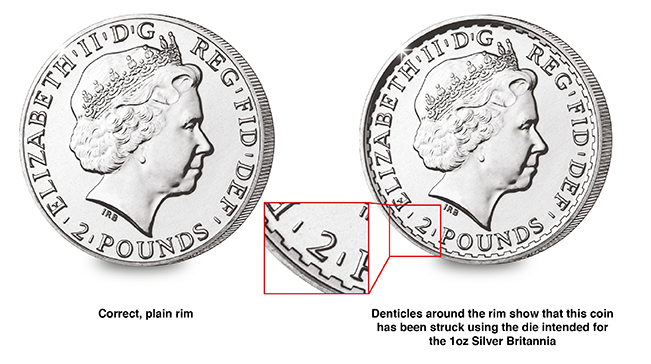Posts by Change Checker
Unprecedented release of bullion coin designs in base metal by Royal Mint
The Royal Mint has today confirmed the release of two new base metal £5 Coins– one featuring the Lion of England and the other the Unicorn of Scotland, available to order today.

New Lion of England and Unicorn of Scotland coin released today in base-metal
In fact, the Lion of England design was first revealed in 2016 but appeared to be released solely for use with gold and silver bullion coins. However, the design by Jody Clark (the man behind the current Queen’s effigy) met such popular acclaim that the Royal Mint has now confirmed its release in brilliant uncirculated base-metal.
Unprecedented in the modern era

Pistrucci’s St. George & the Dragon design has been used on a number of different specifications over the past 200 years but only once, in 1951, on a base metal coin.
The use of a bullion coin design on a base-metal coin is unprecedented in the modern era, often meaning that some of the UK’s very best coin designs, used on Britannia and Sovereign coins, have simply been too expensive for change collectors to own.
In fact, it is only Pistrucci’s St. George and the Dragon that has ever appeared on a base metal coin, under George VI in 1951, notably at a time when the Sovereign was not even being issued as a bullion coin.
More base metal issues to look forward to

The Lion of England and Unicorn of Scotland famously adorn the Royal Coat of Arms
So does this mean that we can expect to see Pistrucci’s St. George and the Dragon and the latest Gold and Silver Britannia Coin designs available in base metal?
Sadly, I think not. But there is some good news for collectors who love Jody Clark’s Lion design.
The Royal Mint has also revealed an accompanying Unicorn of Scotland £5 coin, enabling collectors to own both “supporters” of the Royal Coat of Arms.
Will there be eight more coins to collect?
Whilst the Unicorn of Scotland coin is yet to be released in Silver and Gold it is ear-marked to be part of a continued series of Silver, Gold and Platinum Bullion coins to be issued over 5 years. The set is inspired by the Queen’s Coronation Beasts that lined the entrance to Westminster Abbey for her coronation in 1953.

The Queen’s Beasts lined the entrance to Westminster Abbey for the Coronation in 1953
Currently there is no final confirmation from the Mint, but it seems likely the remaining eight coins will follow in brilliant uncirculated base-metal over the coming 4 years- a definite highlight for base metal collectors. And if the popularity of the precious metal coins is anything to go by, this latest release will be a guaranteed winner with base metal collectors too.
The new Lion of England and Unicorn of Scotland £5 Coins are available to order today in certified Brilliant Uncirculated Condition- CLICK HERE
Change Checker Encyclopedia – Coin terminology made easy!
 The thing we love about coin collecting is that anybody can do it…but, we’re aware that to those who are not seasoned collectors, some of the terminology can be a bit daunting. So we decided to draw up a go-to terminology list, the Change Checker Encyclopedia, to ensure you never confuse your ‘base metal’ from your ‘bi-metallic’ again!
The thing we love about coin collecting is that anybody can do it…but, we’re aware that to those who are not seasoned collectors, some of the terminology can be a bit daunting. So we decided to draw up a go-to terminology list, the Change Checker Encyclopedia, to ensure you never confuse your ‘base metal’ from your ‘bi-metallic’ again!
Face Value
The face value of coins is usually its legal value. However, their market value usually doesn’t bear any relationship to the face value as collectors pay close attention to the coin’s metal content, finish and rarity.
Obverse
This is the side of the coin which features the monarch’s head- hence “Heads”
Reverse
This is the opposite side of the coin to the monarch’s head and commonly referred to as “tails”. This will usually feature an emblem or another design.
Circulated
These are the coins that you find in your change. As they’ve been circulated among the population they’re likely to show some wear and tear.
Uncirculated
A coin in a new condition fresh from the Mint originally intended for circulation but not circulated. Usually they have some small scratches and marks.
Brilliant Uncirculated
These coins are struck to a superior finish and don’t have the scratched or blemishes you’ll find on the coins in your change.
Proof
‘Proof’ refers to the finish of a coin and is often a favourite amongst collectors. Proof coins are struck several times with special highly polished dies and usually have a mirror lustre finish, with frosted relief.
Blank
This is a disc-shaped piece of metal onto which a coin image is struck or pressed
Base Metal
This is a common and inexpensive metal, usually either Cupro-Nickel or Nickel Brass, used to produced coins for circulation.
Milled Coin
This is any coin that has been struck in a coining press.
Die
This is a block of hardened metal that has a design or effigy engraved on to it. It is used to impress the design onto a coin blank.
Strike
This is the final stage of the coin making process where an image is pressed (using huge force created by two dies) onto both sides of a coin blank.
Bi-Metallic
A coin made from the combination of 2 metals or alloys, our £2 and the new 12-sided £1 coin are good examples.
Mis-Strike
The striking process is never fully exempt from human error and sometimes a coin can become mis-aligned during the striking process, making it a mis-strike.
Error
Genuine errors, such as the undated 20p and ‘silver’ 2p are extremely rare. If you think you’ve found one you can send an image to [email protected] and we would be happy to take a look.
Mule
A mule coin is struck with an obverse and reverse that is not meant to be paired, such as this 2014 ‘Year of the Horse’ coin.
The wrong obverse (Queen’s head) die was selected when the coin was struck, leaving just 17,000 of the several hundred thousand mintage with the incorrect finish around the edge of the coin. No-one noticed until it was too late and the coins had already been released to bullion dealers.

Mintage Figures
Simply speaking the mintage figure is the total quantity of a specific coin that has been struck. This can be higher than the ‘edition limit’ depending on how the coin is offered. Mintage figures are only one of the guides to the collectability of coins as over time coins will be withdrawn from circulation due to damage, they may get lost or be retained by collectors.
Mint
This refers to any organisation authorised to strike coins and medals. The British Royal Mint is one of the oldest and most respected in the world dating back to the 7th century.
You can download the images from the Change Checker Encyclopedia so that you always have a copy to hand.
Not everybody is happy with Jane Austen’s ‘makeover’ on the new £10 note
2017 marks 200 years since the death of Jane Austen– one of the best-loved English novelists of all time. And to celebrate such an inspirational female figure, both The Royal Mint and the Bank of England have chosen to honour her on a brand new coin and bank note this year.
In fact, this is the first time ever that someone has featured on a circulation coin and banknote at the same time– other than the reigning monarch.
But, all is not well. In an era where airbrushing celebrity photos is par for the course it is perhaps surprising that there has been such uproar regarding Jane Austen’s portrait on the new £10 note.

A portrait of Jane Austen, considered a genuine likeness, compared to her portrait on the new £10 note.
However, many people are upset that she appears to have had the Photoshop treatment; altering her real image to one ‘better suited’ to this modern age. With some even going as far to say she has been made into a Disney princess. Although the difference is not drastic, it is clear that a few minor tweaks have been made.
It seems as though it is not a good idea to mess with the appearance of such a well loved English icon.
We’d certainly be interested to hear your thoughts on the matter, let us know by answering our poll.
[polldaddy poll=9753530]










